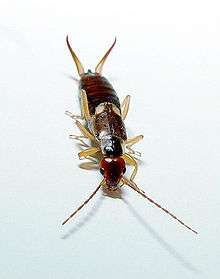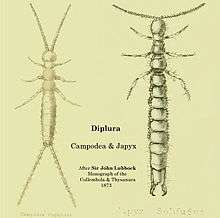Cercus
Cerci (singular cercus) are paired appendages on the rear-most segments of many arthropods, including insects and symphylans. Many forms of cerci serve as sensory organs, but some serve as pinching weapons or as organs of copulation.[1] In many insects, they simply may be functionless vestigial structures.

In basal arthropods, such as silverfish, the cerci originate from the eleventh abdominal segment. As segment eleven is reduced or absent in the majority of arthropods, in such cases, the cerci emerge from the tenth abdominal segment.[2] It is not clear that other structures so named are homologous. In the Symphyla they are associated with spinnerets.[1]
Morphology and functions
Most cerci are segmented and jointed, or filiform (threadlike), but some take very different forms. Some Diplura, in particular Japyx species, have large, stout forcipate (pincer-like) cerci that they use in capturing their prey.[3]
The Dermaptera, or earwigs, are well known for the forcipate cerci that most of them bear, though species in the suborders Arixeniina and Hemimerina do not. It is not clear how many of the Dermaptera use their cerci for anything but defense, but some definitely feed on prey caught with the cerci, much as the Japygidae do.[3]
Crickets have particularly long enclosures, while other insects have enclosures that are too small to notice. However, it is not always obvious that small enclosures have no function; they are rich in sensory cells that detect changes in air currents and can also be important to guide copulation and oviposition.
Some insects such as mayflies, silverfish, and bristletails have an accompanying third central tail filament which extends from the tip of the abdomen. This is referred to as the terminal filament and is not regarded as a cercus.[2]
Aphids have tube-like cornicles or siphunculi that are sometimes mistaken for cerci but are not morphologically related to cerci.
Evolutionary origin
Like many insect body parts, including mandibles, antennae and stylets, cerci are thought to have evolved from what were legs on the primal insect form,[3] a creature that may have resembled a velvet worm, Symphylan or a centipede, worm-like with one pair of limbs for each segment behind the head or anterior tagma.[4]
Gallery
- Short cerci on abdomen of a species of Pamphagid grasshopper
 Long sensory cerci on Ctenolepisma, flanking the median cerciform appendage and paired stylets
Long sensory cerci on Ctenolepisma, flanking the median cerciform appendage and paired stylets Two forms of Diplura, illustrating cerci with sensory glandular function, as contrasted with forcipate forms of cerci used in predation
Two forms of Diplura, illustrating cerci with sensory glandular function, as contrasted with forcipate forms of cerci used in predation
References
- Tiegs, O. W. The post-embryonic development of Hanseniella agilis (Symphyla). Printed at the University Press, 1945.
- "CERCI AND TERMINAL FILAMENT". Entomological Glossary. University of Minnesota. Archived from the original on 25 February 2012. Retrieved 3 June 2014.
- Richards, O. W.; Davies, R.G. (1977). Imms' General Textbook of Entomology: Volume 1: Structure, Physiology and Development Volume 2: Classification and Biology. Berlin: Springer. ISBN 0-412-61390-5.
- David Grimaldi (16 May 2005). Evolution of the Insects. Cambridge University Press. ISBN 978-0-521-82149-0.
External links
